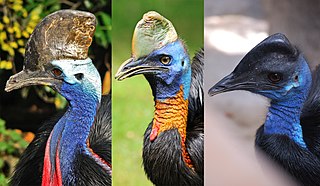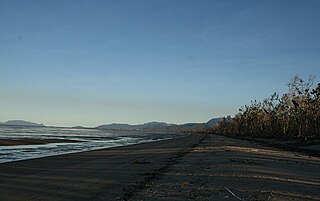
Cassowaries are flightless birds of the genus Casuarius in the order Casuariiformes. They are classified as ratites: flightless birds without a keel on their sternum bones. Cassowaries are native to the tropical forests of New Guinea, The Moluccas, and northeastern Australia.

The Daintree National Park is located in Far North Queensland, Australia, 1,757 km (1,092 mi) northwest of Brisbane and 100 km (62 mi) northwest of Cairns. It was founded in 1981 and is part of the Wet Tropics of Queensland. In 1988, it became a World Heritage Site. The park consists of two sections—Mossman Gorge and Cape Tribulation, with a settled agricultural area between them which includes the towns of Mossman and Daintree Village.

Girramay is a national park in Queensland, Australia, 1269 km northwest of Brisbane. The national park is part of the Wet Tropics World Heritage Area.

Ella Bay is a national park beside Ella Bay and spans the localities of Wanjuru in the Cassowary Coast Region and Eubenangee in the Cairns Region, Queensland, Australia.

Eubenangee Swamp is a national park in Eubenangee in the Cairns Region, Queensland, Australia, 1332 km northwest of Brisbane. It is part of the Coastal Wet Tropics Important Bird Area, identified as such by BirdLife International because of its importance for the conservation of lowland tropical rainforest birds. It plays home to over 190 species of birds.
Moresby Range is a national park in the Cassowary Coast Region in Far North Queensland, Australia, 1,314 kilometres (816 mi) northwest of Brisbane. It is part of the Coastal Wet Tropics Important Bird Area, identified as such by BirdLife International because of its importance for the conservation of lowland tropical rainforest birds.

The Queensland tropical rain forests ecoregion covers a portion of the coast of Queensland in northeastern Australia and belongs to the Australasian realm. The forest contains the world's best living record of the major stages in the evolutionary history of the world's land plants, including most of the world's relict species of plants from the ancient supercontinent of Gondwana. The history of the evolution of marsupials and songbirds is also well represented.

The Wet Tropics of Queensland World Heritage Site consists of approximately 8,940 km2 of Australian wet tropical forests growing along the north-east Queensland portion of the Great Dividing Range. The Wet Tropics of Queensland meets all four of the criteria for natural heritage for selection as a World Heritage Site. World Heritage status was declared in 1988, and on 21 May 2007 the Wet Tropics were added to the Australian National Heritage List.

Mission Beach is a coastal town and locality in the Cassowary Coast Region, Queensland, Australia. In the 2016 census, the locality of Mission Beach had a population of 815 people.

The Daintree Rainforest, also known as the Daintree, is a region on the northeastern coast of Queensland, Australia, about 105 km (65 mi), by road, north of the city of Cairns. Whilst the terms "Daintree Rainforest" and "the Daintree" are not officially defined, it is generally accepted and understood that they refer to the area from the Daintree River north to Cooktown, and from the coastline west to the Great Dividing Range. The popular tourist destination of Mossman Gorge, some 30 km (19 mi) south of the Daintree River, is often included in the definition.
"Tam o' Shanter" is a 1790 poem by Robert Burns.

Ella Bay is a bay located in the Cassowary Coast Region in Far North Queensland, Australia. It is in close proximity to the town of Innisfail. Innisfail is situated 88 kilometres (55 mi) south of Cairns and 260 kilometres (160 mi) north of Townsville. The bay is bounded by Cooper's point in the north and Heath's point in the south. The land area adjacent to Ella Bay is named Wanjuru.
Tam O'Shanter Point is a headland located in South Mission Beach, Cassowary Coast Region, Queensland, Australia on the north-eastern part of Rockingham Bay in the Coral Sea. It is part of the Coastal Wet Tropics Important Bird Area, identified as such by BirdLife International because of its importance for the conservation of lowland tropical rainforest birds.

The Coastal Wet Tropics Important Bird Area comprises a disjunct 521 km2 stretch of coastal and subcoastal land in tropical Far North Queensland, Australia. It extends from just south of Cairns in the north for about 150 km to Cardwell in the south. It is important for the conservation of lowland rainforest birds, especially southern cassowaries.

South Mission Beach is a coastal town and locality in the Cassowary Coast Region, Queensland, Australia. In the 2021 census, the locality of South Mission Beach had a population of 968 people.
Tam O'Shanter is a rural locality in the Cassowary Coast Region, Queensland, Australia. In the 2021 census, Tam O'Shanter had "no people or a very low population".
Djiru is a coastal locality in the Cassowary Coast Region, Queensland, Australia. In the 2021 census, Djiru had "no people or a very low population".
Mount Mackay is a locality in the Cassowary Coast Region, Queensland, Australia. In the 2021 census, Mount Mackay had "no people or a very low population".
Palmerston is a rural locality split between the Tablelands Region and the Cassowary Coast Region, Queensland, Australia. In the 2021 census, Palmerston had a population of 8 people.
Tully Training Area is a heritage-listed rainforest in a military training area at Tully-Cardstone Road, Tully, Queensland, Australia. It was added to the Australian Commonwealth Heritage List on 22 June 2004.













